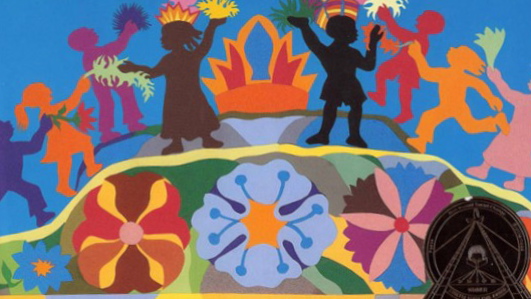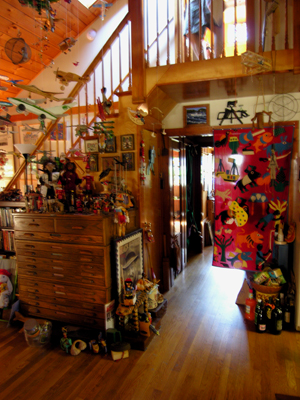Ashley Bryan ⎥ Opening Paths to Exploration
A story of courage, ethnicity, generosity, and inspiration.
CLICK ON LINKS BELOW TO LISTEN TO ASHLEY’S RECORDING.
Renowned for the extraordinary range and depth of his talent, Ashley Bryan is an artist, a writer, a poet, an anthologist, a storyteller, and a noted scholar of African and African American folklore.
His children’s books are full of love – all embracing, inspiring, warm, colorful, joyous, and bursting with song. He works largely with Black African-American poetry and spirituals.
Ashley hopes that his work with African tales will be like “a tender bridge” connecting past to present, reaching across distances of time and space. Ashley’s numerous awards and honors include the Coretta Scott King Award for Illustration; six Coretta Scott King Honors; the Arbuthnot Prize, one of the highest honors in children’s literature; and a Fulbright Scholarship.
His poetry and paintings have and continue to influence a whole generation of children.
Born in 1923 in Harlem to West Indies immigrants, Bryan’s childhood was filled with books, music, and art, even though resources tended to be scarce during the Great Depression. Second of six children, Bryan cannot remember a time when he was not drawing or painting.
His first memories were of his parents sending him to Government run WPA classes which were free, and where he learned to draw, paint and play musical instruments. Ashley’s mother sang and his father played the piano.
After graduating from high school, he applied for a scholarship at a prominent art institution, but was essentially told that a scholarship would not be wasted on a colored person. Under the guidance of his high school teachers, Bryan then applied and was accepted into New York’s prestigious Cooper Union Art School. Two years at Cooper Union and Ashley was drafted into the army to serve in World War II. At the age of nineteen, as a part of the fleet that sailed to Normandy for the surprise invasion, Bryan drew whenever he could, keeping a sketch pad and art supplies in his gas mask.
From there, Bryan went on to study philosophy at Columbia University to, as he says, “understand war.” He received a Fulbright scholarship to study art in Europe, and became the head of the art department at Dartmouth College.
Ashley Bryan lives on Little Cranberry Island off the coast of Maine.
The above copy is taken from numerous sources, including Wikipedia, Reading Rockets, and Simon and Schuster author profiles.
TRACK ONE: INTRO TO RECORDING –
TRACK TWO: EARLY YEARS IN THE BRONX –
TRACK THREE: THE IMPORTANCE OF COMMUNITY –
TRACK FOUR: WORLD WAR II –
TRACK FIVE: THE ALL-WHITE WORLD OF CHILDREN’S BOOKS –
TRACK SIX: AFRICAN FOLK TALES –
TRACK SEVEN: AFRICAN SPIRITUALS –
The transcription from the first section of our interview follows:
Growing Up in the Bronx / Discovering the Importance of Community
I was born in New York City on July 13, 1923 of immigrant parents who had come from Antigua in the West Indies. They had six children; I was the second. I was raised in the Bronx during the Depression years. My parents provided food, clothes, and shelter but they couldn’t afford other things.
At that time there was the WPA, the Works Progress Administration. They offered free art and free music classes for communities throughout the country. My parents sent the six of us to all the things that were free that would help us to develop ourselves creatively. We worked with whatever materials we could find to recreate them, to make something of them — things that we would find on the streets – including fabrics and things from upholstery stores. My sister and I would bring them home and rework them into quilts, into skirts and jackets. We were always working with castoff materials, recreating them, bringing them into another form of life, which is a pattern that has stayed with me through life.
The good thing about growing up in tenement apartments was that we knew everyone in the house. Everyone looked after the other. My parents took care of the elders in the house. In good weather people sat out on the streets. They would bring their instruments, their music, what they would drink in the warm weather. They always had an eye out for the children. It was a different world in the 1930’s growing up in the city, which was broken down into small communities. It was that sense of community, which I’ve carried through life, which followed me to these islands off the coast of Maine. That’s what helped me decide that this would become my year-round home, because the community that I found here reminded of my New York City tenement apartment.
Cooper Union and Columbia University
My father was a printer but when he came to the United States, being a black man, all he was offered was a mop and broom. My dad never talked about racism. He simply said, “I knew I wasn’t going to last long in a job like that.” So, he went to the British Consulate and got a certificate from them stating that I had served in His Majesty’s Army and that he had worked as an apprentice printer as a child. That gave him an entrance into a downtown printing plant and that’s where he worked. He said it gave him a chance to be expressive in his work. And he was always bringing home extra papers from work. So I had these beautiful papers to work with.
I also had the good fortune of having wonderful teachers in elementary school. I had all white teachers throughout elementary, junior high, and high school. They all encouraged me. They always recognized my talent and gave me the materials that I needed to keep growing in my love of art.
In high school I joined the Art Club and, on graduation, I had the help of my teachers to prepare a very strong portfolio. Before graduating, they gave me the list of art schools in New York City to go to. So I went from art school to art school and was told – and this is New York City – “this is the best portfolio we have seen, but it would be a waste to give a scholarship to a colored person.” When I came back to the high school and told that to my teachers, they said, “Ashley, come back and take a post-graduate course.” They knew I was black, I knew I was black, and there was no problem. It didn’t occur to them that I would need anything beyond my talents. So they said, come back, take a post-graduate course, work on your portfolio, and in the summer take the exam for the Cooper Union School of Art and Engineering. They do not see you there. So, that summer I took the exam. At that time, in 1940, there were three exercises: one in drawing, one in sculpture, and one in architecture.
When you finished those exercises, you put your work on a tray with all the information of who you are on the platform of the Great Hall. It’s a very famous hall, where all of our presidents have lectured, from the earliest time. It was founded in1850 for the working young men and women of the country, primarily for young women working in all aspects of the garment trade and for young men in engineering, as Peter Cooper was an outstanding engineer. So, I took the exams, I put it on my tray and left. Then professors looked over all of the work, and they selected those they wanted for admission to the Cooper Union. I was fortunate in being one of them. I was the only black in my class, but I had grown up in a mixed community of French, German, Italian, and Irish. I became close friends with the students there. We have followed each other through life. The very few, who at ninety, are still alive, I’m still very close to.
Interrelationships
I was never a loner. I was always with others. I was alone in my art, creating my art. All artists and composers, in whatever form, they have to be alone in developing in what they do. But I always loved being with others and sharing my work. And I always had the respect of others, because of my real love of doing my work – and my respect for what they did. I was lousy in sports. I’d be the last one chosen on any team. But they understood that and they spoke of me as the artist of the community. I was never picked on. I don’t know why that is, other than I always had such a deep respect for what other people do that it never occurred to me that there was any kind of a hierarchy. You could be sweeping a street and I would respect what you were doing and your work in that community.
My work in the community was always open to people dropping in. I drew so much from just the informal visits and what they would have to say. You know, I think that’s why I say I don’t believe in interruptions in my life. Right now, talking with you, I am creating. I am drawing, I’m painting, I’m doing my bookwork, I’m doing my puppet work, my sea glass work. There is no interruption. Everything that is happening to me I feel is significant. There is no way you can take my time. It’s the one thing that I possess. I can only offer it to you in exchange for your precious gift of your time, so remain on a level of back and forth, you see. And that is why my door is always open and people will come and go. But they come and they say, “Oh, we’re interrupting you.” No! Look! Do you want to see my paintings, do you want to see my drawings, do you want to see my sea-glass work, do you want to see my bookwork? I am always producing.
WWII / Looking for answers
When I came back from the Second World War I was so spun around, as veterans are, it was difficult to go on. Well, I knew when I came back (I was inducted at nineteen) that I wanted to complete my studies at Cooper Union. So, I knew my direction. I was not like veterans who don’t have a direction. After the experiences of a war, they find it difficult to adjust and go one. Very often then, because they don’t have enough services to keep following them up, they fall through. And that’s why, when they say a third of the homeless are veterans, it’s very understandable, because without help of family, friends, or a direction in life, or a medical support system that will follow them closely, it’s very hard after those experiences, to say you’re normal and go on. That’s what I experienced when I came home. I knew I wanted to complete my course study, but I also knew I wanted to understand why man chooses war. So when I graduated from Cooper Union, I did undergraduate work as a philosophy major at Columbia, to see if I could find answers. And I only found more questions. But I was so intrigued by the way man thinks, in aesthetics and ethics, in logic, and these areas, which I studied, that I stayed with it. Summers I’d come up to Maine and I’d be outdoors painting the whole time. That’s what really gave me a focus and direction. When I graduated from Columbia University, I knew I would not go any further in studies.
Please check back regularly. More of the transcription to follow.
Made possible with funds provided by the Wolf Kahn and Emily Mason Foundation.



